Marriage of Opposites
January 13th, 2011This article originally appeared on January 13, 2011 in The Island. Michele Ellson, editor. Reprinted with additional links.
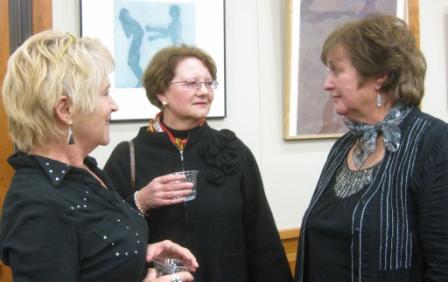
From left: Maryly Snow, Herlinde Spahr, Bonnie Randall Boller. Photo by Michael Singman-Aste.
The California Society of Printmakers (CSP) held the reception for their 98th annual membership exhibition at the Alameda Public Library’s main branch on January 5. Yes, ninety-eighth. Founded in 1912 as the California Society of Etchers, the CSP is the oldest continuously operating society of printmakers in the United States.
Three artists — Maryly Snow, Bonnie Randall Boller, and Herlinde Spahr — were chosen from among those who volunteered to speak in the Regina K. Stafford Meeting Room about their work and the exhibit’s theme, “A Marriage of Opposites: Love & Hate, Life & Death, Heaven & Hell.”
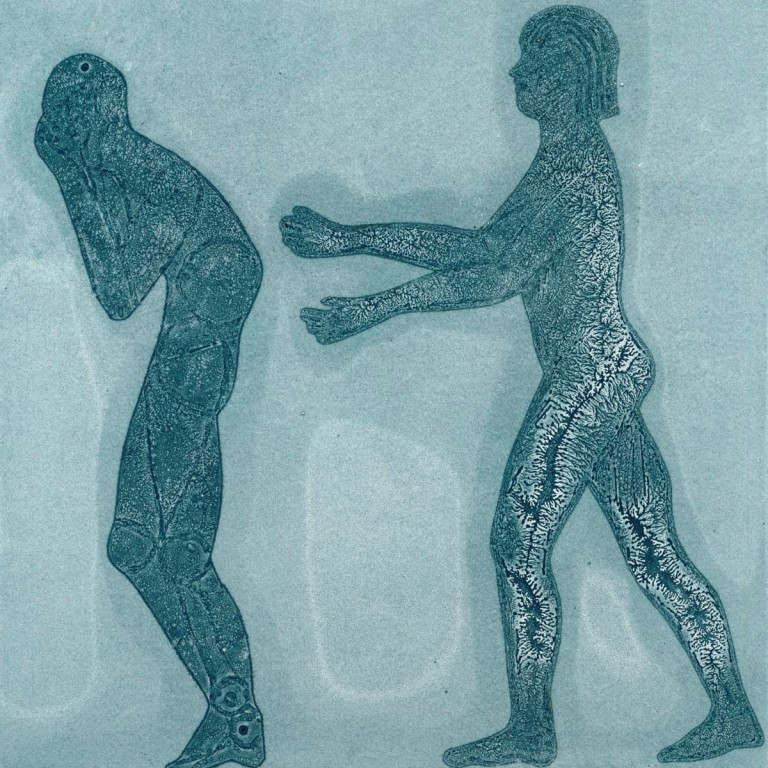
Maryly Snow, “Weeping Man #5,” 2009. Monoprint.
Maryly Snow’s “Weeping Man #5” incorporates a variety of dichotomies: Male/female, weeping/solace, remorse/salvation, and humanity/mother nature. She describes it as a “ghost monoprint” because it is the result of a second run of painted Plexiglas through the press after the first removed some of the ink. She says, “Often ghosts are a little too pale and they lack a little bit of structure,” but an experience at the studio of printmaker Glen Rogers in Mazatlan changed that perception.
“There were 10 of us in her workshop, and she picked one piece from each of us to put out on some tables when people came through her studio. She picked that (ghost monoprint), and I was really puzzled. It’s very simple. It’s very plain. Because she and other people respond to this one, that made me start liking it more, which is an interesting example I think of how the artist can change his or her mind about whether they like their own work over time. And getting feedback from your viewers is important, because it helps the artist see differently.”
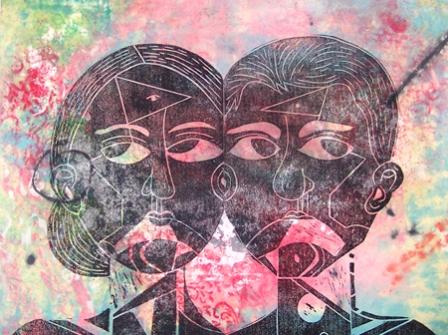
Bonnie Randall Boller, “Merged,” 2010. Clay monotype and linocut.
“My history is a merging of different things,” said Bonnie Randall Boller, who originally worked in ceramics, and discovered printmaking around 2003. In her piece “Merged,” the background is a clay monotype on a non-woven man-made fabric, and the foreground is two different linocuts made at different times.
“The original one was the woman … And then later I wanted to merge, because of things that were going on in my life, and I decided to make a male image also,” Boller said. “When this show came I thought, ‘This is where I need to put my life back together again, because I feel like I’ve been running in this direction and that direction, and I needed some unity.’ And this topic was ideal for that. So I have merged the clay monotype with the linocut. I merged the two different linocuts together that were made at different times. They were done with transparent inks so that there is a merging of the background and the foreground together.
“I’m really excited because this show pushed me a little bit by getting me to put the two together. And the possibilities of that appeared only this January. And so by June, if anybody can get to my open studios, who knows what’s going to happen?” she added.
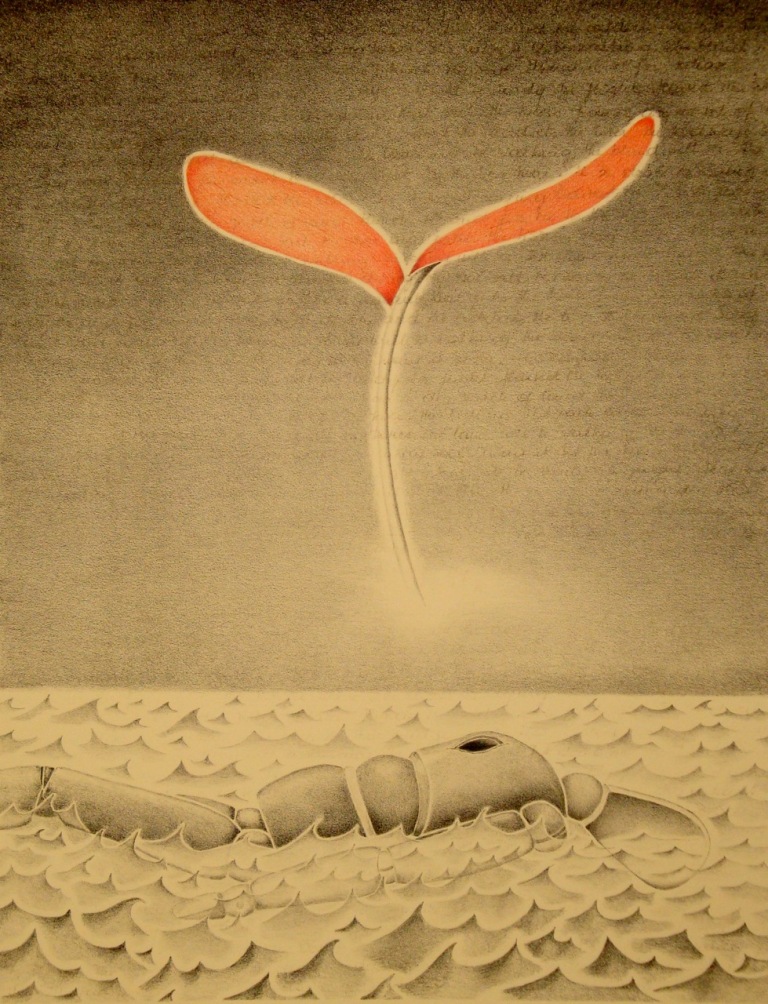
Herlinde Spahr, “Lying Awake, First Night,” 2010. Stone lithograph.
“Lying Awake, First Night” depicts an artist’s wooden mannequin floating in the sea, a plant growing above it. In describing the inspiration for her piece, Herlinde Spahr spoke of finding a dead willow that had been cut down and its stump fashioned into a seat. Upon returning to the spot weeks later she discovered that green shoots had sprouted all over it. “And it was like a throne with feathers!” she recalled. “And it was amazing because it was a mockery of the seat that was there. And in a way this dead wood growing something completely new, may well have been influenced by that moment.”
Spahr said that her artistic process is like that. Lying awake at night in the dark and quiet, she sets her creativity free. “The imagination is this amazing moment in which something comes alive out of nothing. Something growing and flamboyant that you just cannot understand,” she said.
Close inspection reveals the barely visible text of a poem written by Spahr in the background, added to the work in a second run through the press. “If you were to own this piece you could probably read what it says, but when you just walk by you can’t,” she said. In closing, she read the piece aloud:
When I’m dead or dying, harvest me
Like a peasant that picks the tubers from a dry patch of land.
Plunder me and give me to the poor.
To the drunks and the addicts, deliver the kidneys.
Peel back the skin and gather the tissues.
Scoop out my heart and collect all my bones.
The lame will be walking. The blind will see.
But don’t touch my soul.
Promise you won’t touch my soul.
I want it set free, released from its tethers.
By the time that I am dead or dying
My soul will be ready for flight.
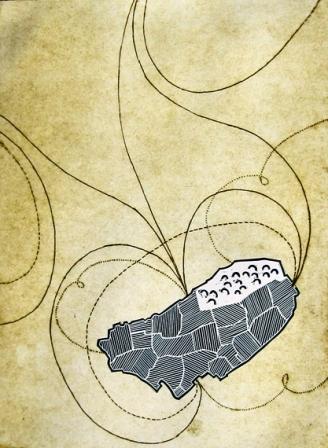
Macy Chadwick, “Walled Towns, Let Me In,”2010. Collagraph with linoleum.
Next to Spahr’s piece hangs “Walled Towns, Let Me In” by Macy Chadwick, an instructor in book arts at both San Francisco Art Institute and Academy of Art University in San Francisco whose work is part of the collection at the Alexandria Library in Egypt.
The geography looks suspiciously like Alameda. Is the title a comment on metaphorical borders separating Alameda from neighboring communities? Perhaps a reference to the decades a resident needs to live here before being considered a native? Neither, according to Chadwick, who has been working on a series of prints about the walled towns of Italy. “It is indeed a coincidence that the town resembles Alameda but I am so intrigued by that idea.”
The walled city depicted in this piece is in fact Orvieto, located in the Umbria region of Italy. Umbria is the only landlocked region on the Italian peninsula, and so was somewhat less vulnerable to foreign invaders. Chadwick explains that the cities were walled against each other as well. “Art has to do with human relationships. It’s a metaphor for emotionally walling yourself in and walling others out,” she said.
The exhibit includes approximately 70 pieces on both floors of the library. Other particularly noteworthy pieces with a strong narrative quality and emotional punch include the linoleum etch “Why?” (2008) by Rob Rocco, a new member juried in to the society in 2009, “Pulling the Tides” (linocut, 2010) by Patricia Theobald Payne, and “Life is but a Dream” (woodcut, 2010) by Susana Terrell.
The exhibition runs through January 29. The library is located at 1550 Oak Street. The Regina K. Stafford Meeting Room is open during library hours, which are noon to 8 p.m. Monday, 10 a.m. to 8 p.m. Tuesday through Thursday, 10 a.m. to 5 p.m. Friday and Saturday and 1 p.m. to 5 p.m. Sunday.
Michael Singman-Aste
Postdiluvian Photo
Tags: Alameda, Alameda Free Library, Bonnie Randall Boller, California Society of Printmakers, Herlinde Spahr, Macy Chadwick, Maryly Snow, Patricia Theobald Payne, Rob Rocco, Susana Terrell, The Island



Leave a Reply
You must be logged in to post a comment.